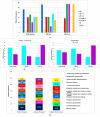A Comprehensive Analysis of Echinococcus granulosus Infections in Children and Adolescents: Results of a 7-Year Retrospective Study and Literature Review
- PMID: 39861014
- PMCID: PMC11768134
- DOI: 10.3390/pathogens14010053
A Comprehensive Analysis of Echinococcus granulosus Infections in Children and Adolescents: Results of a 7-Year Retrospective Study and Literature Review
Abstract
Cystic echinococcosis (CE) is a neglected tropical parasitic disease linked with significant social and economic burdens worldwide. The scientific community has minimal information on echinococcosis in Romanian people, and hospital medical records are the only sources that may be used to investigate its status. A 7-year retrospective clinical study on pediatric patients with CE from Southeast Romania was performed, and 39 children and adolescents were included, aged 2-15 years old. They were hospitalized with cystic echinococcosis in the Pediatric Department and Pediatric Surgery Department of Constanta County Clinical Emergency Hospital "St. Apostle Andrew" between 1 January 2017 and 1 October 2024. Twenty-nine (74.36%) pediatric patients came from rural zones, and 10 (25.64%) had urban residences. In total, 28 children (71.79%) had contact with four different animals (dogs, goats, pigs, and sheep); only four were from urban zones, and they had contact only with dogs. Data regarding the length of hospital stay, cyst location, and complications were collected and analyzed. According to the medical files, the diagnosis was established using imaging techniques and serological tests for CE. IgE and IgG reported appreciable variations in correlation with all parameters, and significant differences (p < 0.05) were recorded. IgE levels considerably increased in cases of no animal contact, pulmonary involvement, complications, surgical treatment, and multiple hospitalizations. Moderate IgE values were recorded in cases of urban residences, pig and sheep contact, and hepatic involvement. The IgG concentration considerably increased with sheep contact and moderately increased in cases of rural zones, hepatic involvement, complications, and surgical treatment. The results show that incidental discovery, symptoms, complications, multiple dissemination, pulmonary involvement, and dog and pig contact increase the hospitalization time. Extensive data analysis supports our results. Our findings highlight the complexity of managing E. granulosus infections in children and evidence the importance of a multidisciplinary approach, combining early diagnostic tools, tailored medical therapy, and careful surgical intervention when necessary.
Keywords: Echinococcus granulosus sensu lato; IgE; IgG; Romanian pediatric patients; eosinophilia; hydatid cyst; liver and lung involvement; medical and surgical treatment.
Conflict of interest statement
The authors declare no conflicts of interest.
Figures




Similar articles
-
Signs and symptoms to determine if a patient presenting in primary care or hospital outpatient settings has COVID-19.Cochrane Database Syst Rev. 2022 May 20;5(5):CD013665. doi: 10.1002/14651858.CD013665.pub3. Cochrane Database Syst Rev. 2022. PMID: 35593186 Free PMC article.
-
Home treatment for mental health problems: a systematic review.Health Technol Assess. 2001;5(15):1-139. doi: 10.3310/hta5150. Health Technol Assess. 2001. PMID: 11532236
-
Non-pharmacological interventions for sleep promotion in hospitalized children.Cochrane Database Syst Rev. 2022 Jun 15;6(6):CD012908. doi: 10.1002/14651858.CD012908.pub2. Cochrane Database Syst Rev. 2022. PMID: 35703367 Free PMC article.
-
Atypical antipsychotics for disruptive behaviour disorders in children and youths.Cochrane Database Syst Rev. 2017 Aug 9;8(8):CD008559. doi: 10.1002/14651858.CD008559.pub3. Cochrane Database Syst Rev. 2017. PMID: 28791693 Free PMC article.
-
Frequency and Sequence Analysis of Echinococcus granulosus Sensu Lato Isolated From Buffaloes in Northern Iran.Vet Med Sci. 2025 May;11(3):e70328. doi: 10.1002/vms3.70328. Vet Med Sci. 2025. PMID: 40171972 Free PMC article.
Cited by
-
Clinical and Epidemiological Characteristics of Pediatric Pertussis Cases: A Retrospective Study from Southeast Romania.Antibiotics (Basel). 2025 Apr 23;14(5):428. doi: 10.3390/antibiotics14050428. Antibiotics (Basel). 2025. PMID: 40426495 Free PMC article.
-
Cystic Echinococcosis in Hospitalized Children and Adults from Western Romania: 2007-2022.Microorganisms. 2025 Apr 30;13(5):1035. doi: 10.3390/microorganisms13051035. Microorganisms. 2025. PMID: 40431207 Free PMC article.
-
Protein and Amino Acid Supplementation Among Recreational Gym Goers and Associated Factors-An Exploratory Study.J Funct Morphol Kinesiol. 2025 Jun 28;10(3):248. doi: 10.3390/jfmk10030248. J Funct Morphol Kinesiol. 2025. PMID: 40700184 Free PMC article.
-
Pediatric hepatic hydatid cysts: recurrence risk factors following laparoscopic surgery-a 16-year cohort analysis.Surg Endosc. 2025 Jul 10. doi: 10.1007/s00464-025-11965-1. Online ahead of print. Surg Endosc. 2025. PMID: 40640620
References
-
- Paternoster G., Boo G., Wang C., Minbaeva G., Usubalieva J., Raimkulov K.M., Zhoroev A., Abdykerimov K.K., Kronenberg P.A., Müllhaupt B., et al. Epidemic Cystic and Alveolar Echinococcosis in Kyrgyzstan: An Analysis of National Surveillance Data. Lancet Glob. Health. 2020;8:e603–e611. doi: 10.1016/S2214-109X(20)30038-3. - DOI - PubMed
-
- Casulli A., Abela-Ridder B., Petrone D., Fabiani M., Bobić B., Carmena D., Šoba B., Zerem E., Gargaté M.J., Kuzmanovska G., et al. Unveiling the Incidences and Trends of the Neglected Zoonosis Cystic Echinococcosis in Europe: A Systematic Review from the MEmE Project. Lancet Infect. Dis. 2023;23:e95–e107. doi: 10.1016/S1473-3099(22)00638-7. - DOI - PubMed
-
- WHO . Ending the Neglected Tropical Diseases to Attain. the Sustainable Development Goals. A Road Map for Neglected Tropical Diseases 2021–2030. World Health Organization; Geneva, Switzerland: 2020.
Publication types
MeSH terms
LinkOut - more resources
Full Text Sources

